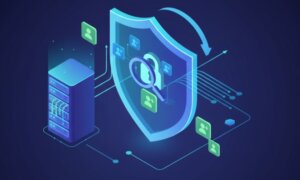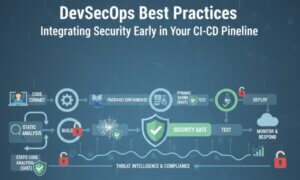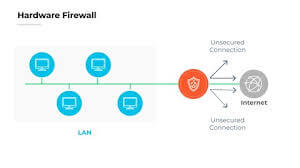Firewalls are a fundamental part of network security, acting as the first line of defense against cyber threats. While software firewalls are widely known and used, hardware firewalls offer robust, dedicated protection for networks and businesses. In this blog, we’ll explore hardware firewalls, their types, applications, differences from software firewalls, and their importance in securing digital assets.
Table of Contents
What is a Hardware Firewall?
A hardware firewall is a physical device designed to monitor and filter incoming and outgoing network traffic based on predefined security rules. Unlike software firewalls, which run on individual devices, hardware firewalls provide centralized protection for entire networks. These devices are commonly found in enterprise environments, data centers, and even in advanced home network setups.
How Hardware Firewalls Work
Hardware firewalls sit between a network and the internet, acting as a gateway that inspects and controls traffic flow. They analyze data packets, determining whether to allow or block them based on security policies. Many hardware firewalls also include intrusion prevention systems (IPS) and deep packet inspection (DPI) to enhance security.
Hardware firewalls come in various forms, catering to different network sizes and security needs. The primary types include:
1. Packet-Filtering Firewalls
Packet-filtering firewalls inspect packets of data at the network layer, allowing or blocking traffic based on IP addresses, ports, and protocols. They provide basic security but lack deep inspection capabilities.
2. Stateful Inspection Firewalls
These firewalls track active connections and make security decisions based on the state of traffic. Unlike packet-filtering firewalls, they can recognize and manage ongoing sessions, making them more secure.
3. Proxy Firewalls
Proxy firewalls act as intermediaries between users and the internet, filtering traffic at the application layer. They provide advanced security features, such as content filtering and malware scanning, but can introduce latency.
4. Next-Generation Firewalls (NGFWs)
NGFWs combine traditional firewall functions with advanced security features like intrusion detection and prevention (IDS/IPS), sandboxing, and machine learning-based threat detection. They offer the highest level of security for modern businesses.
5. Unified Threat Management (UTM) Firewalls
UTM firewalls provide an all-in-one security solution that includes firewall protection, antivirus scanning, intrusion prevention, and VPN capabilities. They are ideal for small to medium-sized businesses.
Where Hardware Firewalls Are Used
Hardware firewalls are essential in multiple environments, providing security for:
Enterprises & Corporations: Large organizations use hardware firewalls to secure sensitive data and prevent cyber threats.
Data Centers: Hosting and cloud service providers deploy robust firewalls to protect their infrastructure.
Small and Medium Businesses (SMBs): Many SMBs use hardware firewalls for affordable, yet effective network security.
Home Networks: Advanced users and smart home setups implement hardware firewalls to enhance security.
Educational Institutions: Schools and universities use firewalls to filter content and prevent cyberattacks.
Hardware Firewall vs. Software Firewall
Both hardware and software firewalls provide security, but they serve different purposes:
| Feature | Hardware Firewall | Software Firewall |
|---|---|---|
| Deployment | Installed at the network perimeter | Installed on individual devices |
| Protection Scope | Protects entire network | Protects a single device |
| Performance Impact | No impact on endpoint performance | Can slow down devices |
| Security Features | Advanced filtering, DPI, IDS/IPS | Basic filtering, app control |
| Cost | Higher upfront cost | Lower initial cost |
| Best Use Case | Businesses, data centers, large networks | Personal use, small offices |
Key Features to Look for in a Hardware Firewall
When selecting a hardware firewall, consider the following features:
Throughput Capacity: Ensure the firewall can handle the bandwidth of your network.
Intrusion Detection & Prevention (IDS/IPS): Helps detect and stop malicious activity.
VPN Support: Allows secure remote access to the network.
Content Filtering: Blocks malicious websites and inappropriate content.
Scalability: The ability to grow with your network.
Ease of Management: User-friendly interfaces for monitoring and configuration.
Conclusion
Hardware firewalls play a crucial role in network security, providing dedicated protection against cyber threats. Whether for businesses, data centers, or advanced home networks, investing in a reliable hardware firewall ensures better security, performance, and peace of mind. Understanding the different types, their use cases, and how they compare to software firewalls will help you choose the best solution for your needs.
Why Businesses Trust SecureMyOrg For Comprehensive Network Security
At SecureMyOrg, we uncover and fix all possible security vulnerabilities of mobile and web, while providing solutions to mitigate risks. We are trusted by renowned companies like Yahoo, Gojek and Rippling, and with 100% client satisfaction, you’re in safe hands!







Some of the things people reach out to us for –
- Building their cybersecurity program from scratch – setting up cloud security using cost-effective tools, SIEM for alert monitoring, building policies for the company
- Vulnerability Assessment and Penetration Testing ( VAPT ) – We have certified professionals, with certifications like OSCP, CREST – CPSA & CRT, CKA and CKS
- DevSecOps consulting
- Red Teaming activity
- Regular security audits, before product release
- Full time security engineers.
Relevant Posts

How To Inspect Encrypted Traffic Without Breaking Privacy
Network administrators face a challenge: securing systems while respecting privacy. This guide explains how to inspect encrypted traffic without breaking privacy using metadata, anomaly detection, and machine learning ensuring visibility, compliance, and trust.

How to Audit Infrastructure as Code (IaC) for Security Vulnerabilities
Discover how to audit Infrastructure as Code (IaC) for security vulnerabilities with this practical guide. Learn to scan IaC files using tools like Checkov, fix issues like exposed resources, and integrate audits into CI/CD pipelines. Protect your cloud systems from misconfigurations and ensure compliance with clear, actionable steps.

DevSecOps Best Practices: Integrating Security Early in Your CI/CD Pipeline
This article provides a practical guide to embedding security into every stage of your CI/CD pipeline. Learn core DevSecOps best practices like SAST, DAST, dependency scanning, secrets management, and compliance automation to catch vulnerabilities early, foster a culture of shared ownership, and build a secure-by-design development process that accelerates release cycles.

5 Cloud Misconfigurations That Lead to Data Breaches
Cloud misconfigurations are one of the leading causes of data breaches, yet they’re also among the most preventable. From exposed storage buckets to weak IAM policies, attackers exploit these mistakes daily. Learn about the top 5 misconfigurations and how your organization can fix them before they lead to costly data exposure.

How Can Ethical Hacking Training Elevate Your Internal Cybersecurity?
Ethical hacking training empowers organizations to strengthen internal cybersecurity by uncovering vulnerabilities before attackers do. From mastering penetration testing to enhancing incident response, this training builds a proactive security culture. Learn how Secure My ORG’s programs can elevate your team’s skills and fortify defenses against modern threats like AI-driven attacks.

AI‑Generated Malware: Threat or Hype?
AI-generated malware uses advanced algorithms to create adaptive and hard-to-detect threats, posing serious challenges for modern cybersecurity defenses. Unlike traditional malware, it can evolve on its own, learning how to bypass security systems without human input. As a result, cybersecurity teams must increasingly rely on AI-driven tools and strategies to detect and neutralize these sophisticated digital attacks.

